2008奥运会鸟巢的英文介绍
- 格式:doc
- 大小:35.50 KB
- 文档页数:9

Bird's NestAbstract:The main venue for the Beijing Olympics, the National Stadium, widely known as the Bird’s Nest because of its unique design, has become a nationwide sensation.The removal of the elements helped to bring the project under the reduced construction budget of $290 million, from an original $500 million. With the removal of the retractable roof, the building was lightened, which helped it stand up to seismic activity; however, the upper section of the roof was altered to protect fans from weather. Due to the stadium's outward appearance, it was nicknamed "The Bird's Nest". The phrase was first used by Herzog & de Meuron, though the pair still believes "there should be many ways of perceiving a building. "The use is a compliment Li explained, "In China, a bird's nest is very expensive, something you eat on special occasions."Introduction:The National Stadium is situated in the Beijing Olympic Green. During the Beijing 2008 Olympic Games, the openingceremony, closing ceremony, trackand field meets, and men's footballfinal will be held here. It is theworld's largest steel structure andthe most complex stadium everconstructed. Its design had to beinspiring and be able to withstandan earthquake. So 'light weight'was combined with strength in 110000 tons of a new grade of steel,the purest ever developed in China, including 36km of steel struts. It has been a landmark and a longstanding symbol of the Olympics. It is "one of the key engineering marvels in the world today."The Bird's Nest was the main venue of the 2008 Beijing Olympic Games and it has a seating capacity of over 91,000. With a simple and classical space effects, the National Stadium is beautifully designed; and all the structural parts support with each other, forming a network framework. It looks like a bird's nest woven with branches. After the Beijing 2008 Olympic Games, the stadium will become a sports and entertainment facility for the residents of Beijing. And it will become another important tourist attraction of Beijing.By the 2001 Pritzker Prize winner Herzog, and the Chinese architect Li Xinggang de Meuron collaborated giant stadium design, forms as life" nest", it is more like a cradle, is entrusted with the mankind's hope for the future. The designers of the National Stadium did not do any extra processing, just give the structure is exposed outside, so the natural formation of the appearance of a building.Design and construction:Located in the Olympic Green, the stadium cost US$423 million. The design was awarded to a submission from the Swiss architecture firm Herzog & de Meuron in April 2003 after abidding process that included 13 final submissions. The design, which originated from the study of Chinese ceramics, implemented steel beams in order to hide supports for the retractable roof; giving the stadium the appearance of a "Bird's nest". Leading Chinese artist Ai Weiwei was the artistic consultant on the project. The retractable roof was later removed from the design after inspiring the stadium's most recognizable aspect. Ground was broken in 24 December 2003 and the stadium officially opened in 28 June 2008. A shopping mall and a hotel are planned to be constructed to increase use of the stadium, which has had trouble attracting events, football and otherwise after the Olympics.The entire structure component of the stadium composes the mutual support to form a grid structure. It looks like a bird's nest and the gray steel mesh is covered by transparent material. It contains a bowl-shaped stadium which is red. Here, the hollow out style, the ceramic lines, the red refulgence and warm, and the most advanced modern steel structure design are perfectly blended together.The whole building is related through the giant reticular structure, without one column in the interior. The stand is shaped like bowl whichgive the stadium unbelievable dramaticism andincomparable appeal. The continuous loop willalso make the audience get the best view andpromote their emotion. It can also encourag eplayers to be faster, higher and stronger. Here,people, really have been given the centerposition.The crust of the stadium can be made by the diaphragm, make to completely waterproof. The sun can penetrate through the transparent roof to meet the growth of the indoor turf. During a game, the stands can change through various ways and can satisfy the different requirements of different audiences. During the Olympic Games, 20000 temporary seats are on the top of the stadium and can ensure that everyone can clearly see the whole game. The entrance, the exit and the crowd flow through the regional division and reasonable streamline design had been settled perfectly.The eastern and western stands of Beijing National Stadium are higher than northern and southern stands, in order to improve sightlines. A 24-hour per day rainwater collector is located near the stadium; after water is purified, it is used throughout and around the stadium. Pipes placed under the playing surface gather heat in the winter to warm the stadium and coldness in the summer to cool the stadium. The stadium's design originally called for a capacity of 100,000 people; however 9,000 were removed during a simplification of the design. The new total of 91,000 would be shaved further when 11,000 temporary seats were removed after the 2008 Olympics; bringing the stadium's capacity to 80,000.The farthest seat is 460 feet (140 meters) from center field. Temperature and airflow of every surface were optimized to increase ventilation.The stadium is like a huge container, whether the last to see or Lex, will give the impression that distinctive, never erase the image, it is fully in line with the National Stadium in the functional and technical requirements, but also from a general Stadium building long-span structures and the digital screen as the main design technique. The spatial effect of the stadium only has the unprecedented originality, but simple, elegant. From here, people can visit, including the stands of the stairs leading to the entire region, including moving lines. Sports hall, is an indoor urban space, with restaurants and shops, its role is just as Commercial Street Gallery, or square, drawing people yearn afternoon a memorable one..Summary:The Bird's Nest, together with the nearby Water Cube, represents the traditional Chinese concept of "round heaven and square earth," as well as the "Qian-kun" and "Yin-yang" ideas. The Bird's Nest is a Beijing's landmark building which represents the most advanced steel structure building system and it support the development of the future building. But the Bird's Nest also has some disadvantages, for example, its maintenance is difficult, and the utilization rate is low after the competition. In the future, we should strive to overcome these difficulties.Source:李志跃在城市化进程中建筑装饰工程功能作用的再解析[期刊论文]-大众科技2011(7)杨嗣信建国60年来我国建筑施工技术的重大发展[期刊论文]-建筑技术2009(9)American Society of Civil Engineers. Prestand and commentary guidelines for the seismic rehabilitation of buildings [ R ] .FEMA2356 , Washington D. C. : Federal Emergency Management Agency , 2000.Chopra A K. Estimating seismic demands for performance-based engineering of buildings [ C] ∥Proceedings of the 13th World Conference on Earthquake Engineering. Mira Digital Publishing ,Canada , 2004 , Paper No. 5007.。

介绍鸟巢的英语小英语作文英文回答:The Bird's Nest, officially known as the National Stadium, is an iconic architectural landmark located in Beijing, China. It was constructed for the 2008 Summer Olympics and hosted the track and field events, as well as the opening and closing ceremonies. The stadium is renowned for its unique and intricate design, which has earned it the nickname "Bird's Nest."The stadium was designed by Swiss architects Jacques Herzog and Pierre de Meuron. Its striking appearance is characterized by a swirling steel framework that resembles a bird's nest. The exterior of the stadium is made up of a complex network of steel beams that intertwine and overlap, creating a visually captivating effect. The stadium is supported by 24 massive concrete columns that are embedded into the ground, providing a stable foundation for the intricate steel structure.The Bird's Nest has a capacity of over 91,000 people, making it one of the largest stadiums in the world. The stadium's interior is designed to provide spectators with a comfortable and immersive experience. The seating bowl is divided into four tiers, each offering a unique perspective of the track and field events. The stadium also features numerous amenities, including VIP lounges, media facilities, and a restaurant.The Bird's Nest has become a symbol of modern China and a popular tourist destination. It has played host to numerous sporting events, concerts, and other events since its completion in 2008. The stadium is a testament toChina's architectural prowess and its commitment to hosting world-class events.中文回答:鸟巢简介。
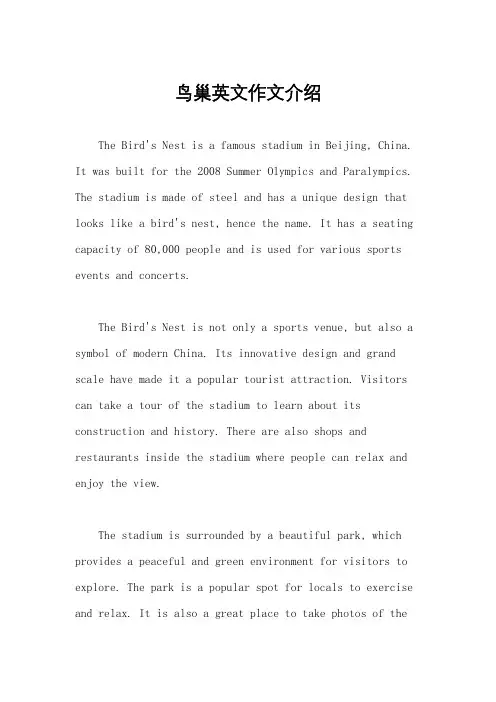
鸟巢英文作文介绍The Bird's Nest is a famous stadium in Beijing, China. It was built for the 2008 Summer Olympics and Paralympics. The stadium is made of steel and has a unique design that looks like a bird's nest, hence the name. It has a seating capacity of 80,000 people and is used for various sports events and concerts.The Bird's Nest is not only a sports venue, but also a symbol of modern China. Its innovative design and grand scale have made it a popular tourist attraction. Visitors can take a tour of the stadium to learn about its construction and history. There are also shops and restaurants inside the stadium where people can relax and enjoy the view.The stadium is surrounded by a beautiful park, which provides a peaceful and green environment for visitors to explore. The park is a popular spot for locals to exercise and relax. It is also a great place to take photos of theBird's Nest from different angles.The Bird's Nest has hosted many important events, including the opening and closing ceremonies of the 2008 Olympics. It has also been used for football matches, concerts, and other cultural events. The stadium's versatile design and state-of-the-art facilities make it a popular choice for various activities.The Bird's Nest has become a symbol of Beijing and a must-see destination for tourists. Its iconic design and historical significance make it a unique and memorable place to visit. Whether you are a sports fan, a history buff, or just someone looking for a cool photo op, the Bird's Nest has something for everyone.。
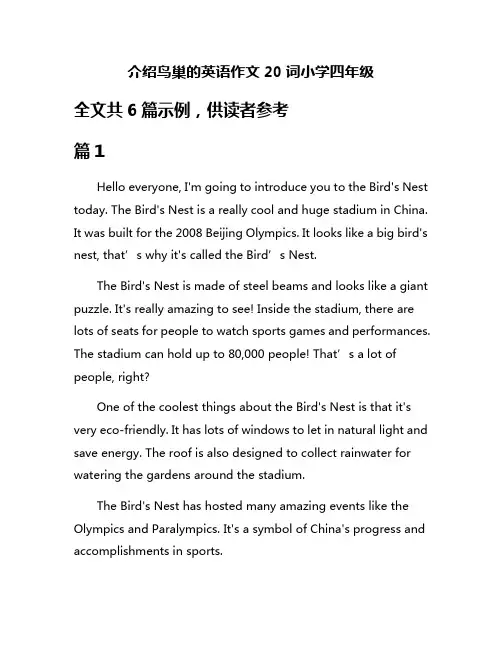
介绍鸟巢的英语作文20词小学四年级全文共6篇示例,供读者参考篇1Hello everyone, I'm going to introduce you to the Bird's Nest today. The Bird's Nest is a really cool and huge stadium in China. It was built for the 2008 Beijing Olympics. It looks like a big bird's nest, that’s why it's called the Bird’s Nest.The Bird's Nest is made of steel beams and looks like a giant puzzle. It's really amazing to see! Inside the stadium, there are lots of seats for people to watch sports games and performances. The stadium can hold up to 80,000 people! That’s a lot of people, right?One of the coolest things about the Bird's Nest is that it's very eco-friendly. It has lots of windows to let in natural light and save energy. The roof is also designed to collect rainwater for watering the gardens around the stadium.The Bird's Nest has hosted many amazing events like the Olympics and Paralympics. It's a symbol of China's progress and accomplishments in sports.If you ever get the chance to visit Beijing, make sure to check out the Bird's Nest. It's a must-see attraction that will leave you in awe of its beauty and engineering. Thank you for listening to my introduction, I hope you liked learning about the Bird's Nest!篇2Hey guys, do you know what the Bird's Nest is? Let me tell you all about it! The Bird's Nest is a super cool stadium in China. It was built for the 2008 Beijing Olympics and it is one of the most famous stadiums in the world.The Bird's Nest is a huge, round stadium that looks like a bird's nest from above. It's made of steel and is covered in a special type of material that makes it look like a giant nest. It has a capacity of over 80,000 people, so it can fit a lot of spectators for sports events and concerts.Inside the Bird's Nest, there are lots of cool things to see. There's a museum where you can learn all about the history of the stadium and the Olympics. You can also take a tour of the stadium and walk on the track where the athletes competed. It's so cool to see where all the action happened!The Bird's Nest is not just for sports events though. It has also hosted concerts, festivals, and other special events. It's areally popular place for people to visit and take pictures. If you ever get the chance to go to China, make sure to check out the Bird's Nest. It's an awesome place to visit!篇3Hi everyone, I'm going to introduce the Bird's Nest to you today! The Bird's Nest is a very cool stadium in Beijing, China. It was used for the 2008 Olympics.The Bird's Nest looks like a big bird's nest, that's why it's called that. It's made of steel and has a lot of little holes in it. The design is really unique and it's very famous all around the world.Inside the Bird's Nest, there's a big field where athletes compete in track and field events. There are also seats for people to watch the games. The stadium can hold a lot of people, so it's always really exciting and noisy during the games.The Bird's Nest is also used for other events, like concerts and shows. It's a really special place where people come together to have fun and enjoy themselves.I hope you can visit the Bird's Nest someday and see it for yourself! It's a really amazing place and I'm sure you'll love it. Thank you for listening to my introduction!篇4Hello everyone, I'm going to introduce the Bird's Nest to you. The Bird's Nest is a famous stadium in Beijing, China. You know, it was built for the 2008 Olympic Games.The Bird's Nest looks like a big nest for birds. It's made of steel and looks very cool. Inside the stadium, there are so many seats for people to sit. When there is a big game on, the stadium will be full of fans cheering for their favorite teams.I have been to the Bird's Nest once with my family. It was so exciting! We watched a football game and I cheered for my favorite team. The atmosphere was amazing with so many people singing and waving flags.Besides sports games, the Bird's Nest also holds concerts and other events. It's a very special place where people from all over the world come together to enjoy their time.If you ever visit Beijing, make sure to go see the Bird's Nest. It's a must-see landmark that you won't want to miss. I can't wait to go back and watch another game there!篇5Hello everyone, today I want to introduce to you the Bird's Nest!The Bird's Nest is a famous stadium in Beijing, China. It was built for the 2008 Summer Olympics, where athletes from all around the world came to compete. It is called the Bird's Nest because it looks like a big nest made by birds.The stadium is huge and can fit over 80,000 people! That's a lot of people, right? The outside of the stadium is covered in a special kind of steel that makes it look like a bird's nest. It's so cool to look at, especially when the sun shines on it.Inside the Bird's Nest, there is a track for running and a field for sports like soccer and rugby. Athletes from all over the world came here to show their skills and compete for medals. It must have been so exciting to watch them!There are also concerts and other events held at the Bird's Nest. People can come and enjoy music and performances in this amazing stadium. It's a great place to have fun with your friends and family.I hope you can visit the Bird's Nest one day and see for yourself how awesome it is. You will be amazed by its size andbeauty. Let's cheer for the athletes and have a great time at the Bird's Nest!篇6Hello everyone! Today, I want to introduce you to a really cool place called the Bird's Nest. Have you heard of it before? It's a famous stadium in Beijing, China.The Bird's Nest was built for the 2008 Summer Olympics, and it's a really big and beautiful stadium. It looks like a giant bird's nest, hence the name. The architects who designed it wanted it to look like a nest because it symbolizes unity and harmony. Isn't that neat?The stadium is made of steel beams that crisscross each other and give it a unique and futuristic look. It can seat over 80,000 people, so it's really huge! The Bird's Nest is also surrounded by a park with walkways and ponds, so you can take a nice stroll around it and enjoy the scenery.One of the coolest things about the Bird's Nest is that you can actually go inside and take a tour. You can see the track where the athletes ran during the Olympics, and you can even go up to the top of the stadium and get a bird's eye view of the city. It's really amazing!I hope you get to visit the Bird's Nest someday. It's a really special place that I think you would enjoy. Thanks for listening!。

Bird's NestAbstract:The main venue for the Beijing Olympics, the National Stadium, widely known as the Bird’s Nest because of its unique design, has become a nationwide sensation.The removal of the elements helped to bring the project under the reduced construction budget of $290 million, from an original $500 million. With the removal of the retractable roof, the building was lightened, which helped it stand up to seismic activity; however, the upper section of the roof was altered to protect fans from weather. Due to the stadium's outward appearance, it was nicknamed "The Bird's Nest". The phrase was first used by Herzog & de Meuron, though the pair still believes "there should be many ways of perceiving a building. "The use is a compliment Li explained, "In China, a bird's nest is very expensive, something you eat on special occasions."Introduction:The National Stadium is situated in the Beijing Olympic Green. During the Beijing 2008 Olympic Games, the openingceremony, closing ceremony, trackand field meets, and men's footballfinal will be held here. It is theworld's largest steel structure andthe most complex stadium everconstructed. Its design had to beinspiring and be able to withstandan earthquake. So 'light weight'was combined with strength in 110000 tons of a new grade of steel,the purest ever developed in China, including 36km of steel struts. It has been a landmark and a longstanding symbol of the Olympics. It is "one of the key engineering marvels in the world today."The Bird's Nest was the main venue of the 2008 Beijing Olympic Games and it has a seating capacity of over 91,000. With a simple and classical space effects, the National Stadium is beautifully designed; and all the structural parts support with each other, forming a network framework. It looks like a bird's nest woven with branches. After the Beijing 2008 Olympic Games, the stadium will become a sports and entertainment facility for the residents of Beijing. And it will become another important tourist attraction of Beijing.By the 2001 Pritzker Prize winner Herzog, and the Chinese architect Li Xinggang de Meuron collaborated giant stadium design, forms as life" nest", it is more like a cradle, is entrusted with the mankind's hope for the future. The designers of the National Stadium did not do any extra processing, just give the structure is exposed outside, so the natural formation of the appearance of a building.Design and construction:Located in the Olympic Green, the stadium cost US$423 million. The design was awarded to a submission from the Swiss architecture firm Herzog & de Meuron in April 2003 after abidding process that included 13 final submissions. The design, which originated from the study of Chinese ceramics, implemented steel beams in order to hide supports for the retractable roof; giving the stadium the appearance of a "Bird's nest". Leading Chinese artist Ai Weiwei was the artistic consultant on the project. The retractable roof was later removed from the design after inspiring the stadium's most recognizable aspect. Ground was broken in 24 December 2003 and the stadium officially opened in 28 June 2008. A shopping mall and a hotel are planned to be constructed to increase use of the stadium, which has had trouble attracting events, football and otherwise after the Olympics.The entire structure component of the stadium composes the mutual support to form a grid structure. It looks like a bird's nest and the gray steel mesh is covered by transparent material. It contains a bowl-shaped stadium which is red. Here, the hollow out style, the ceramic lines, the red refulgence and warm, and the most advanced modern steel structure design are perfectly blended together.The whole building is related through the giant reticular structure, without one column in the interior. The stand is shaped like bowl whichgive the stadium unbelievable dramaticism andincomparable appeal. The continuous loop willalso make the audience get the best view andpromote their emotion. It can also encourag eplayers to be faster, higher and stronger. Here,people, really have been given the centerposition.The crust of the stadium can be made by the diaphragm, make to completely waterproof. The sun can penetrate through the transparent roof to meet the growth of the indoor turf. During a game, the stands can change through various ways and can satisfy the different requirements of different audiences. During the Olympic Games, 20000 temporary seats are on the top of the stadium and can ensure that everyone can clearly see the whole game. The entrance, the exit and the crowd flow through the regional division and reasonable streamline design had been settled perfectly.The eastern and western stands of Beijing National Stadium are higher than northern and southern stands, in order to improve sightlines. A 24-hour per day rainwater collector is located near the stadium; after water is purified, it is used throughout and around the stadium. Pipes placed under the playing surface gather heat in the winter to warm the stadium and coldness in the summer to cool the stadium. The stadium's design originally called for a capacity of 100,000 people; however 9,000 were removed during a simplification of the design. The new total of 91,000 would be shaved further when 11,000 temporary seats were removed after the 2008 Olympics; bringing the stadium's capacity to 80,000.The farthest seat is 460 feet (140 meters) from center field. Temperature and airflow of every surface were optimized to increase ventilation.The stadium is like a huge container, whether the last to see or Lex, will give the impression that distinctive, never erase the image, it is fully in line with the National Stadium in the functional and technical requirements, but also from a general Stadium building long-span structures and the digital screen as the main design technique. The spatial effect of the stadium only has the unprecedented originality, but simple, elegant. From here, people can visit, including the stands of the stairs leading to the entire region, including moving lines. Sports hall, is an indoor urban space, with restaurants and shops, its role is just as Commercial Street Gallery, or square, drawing people yearn afternoon a memorable one..Summary:The Bird's Nest, together with the nearby Water Cube, represents the traditional Chinese concept of "round heaven and square earth," as well as the "Qian-kun" and "Yin-yang" ideas. The Bird's Nest is a Beijing's landmark building which represents the most advanced steel structure building system and it support the development of the future building. But the Bird's Nest also has some disadvantages, for example, its maintenance is difficult, and the utilization rate is low after the competition. In the future, we should strive to overcome these difficulties.Source:李志跃在城市化进程中建筑装饰工程功能作用的再解析[期刊论文]-大众科技2011(7)杨嗣信建国60年来我国建筑施工技术的重大发展[期刊论文]-建筑技术2009(9)American Society of Civil Engineers. Prestand and commentary guidelines for the seismic rehabilitation of buildings [ R ] .FEMA2356 , Washington D. C. : Federal Emergency Management Agency , 2000.Chopra A K. Estimating seismic demands for performance-based engineering of buildings [ C] ∥Proceedings of the 13th World Conference on Earthquake Engineering. Mira Digital Publishing ,Canada , 2004 , Paper No. 5007.。
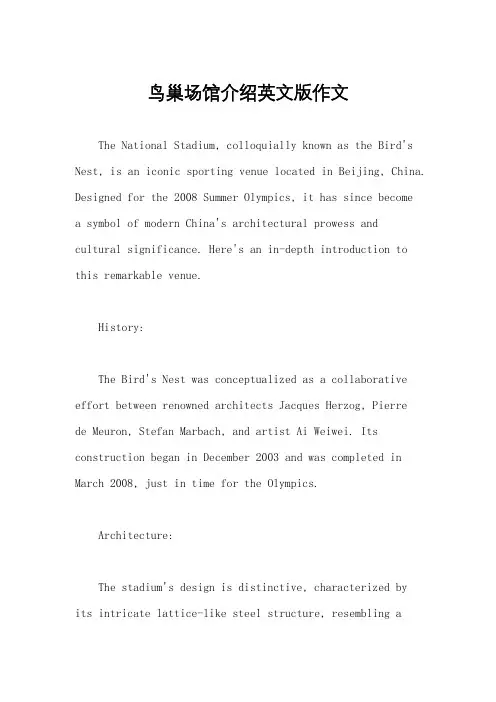
鸟巢场馆介绍英文版作文The National Stadium, colloquially known as the Bird's Nest, is an iconic sporting venue located in Beijing, China. Designed for the 2008 Summer Olympics, it has since becomea symbol of modern China's architectural prowess andcultural significance. Here's an in-depth introduction to this remarkable venue.History:The Bird's Nest was conceptualized as a collaborative effort between renowned architects Jacques Herzog, Pierrede Meuron, Stefan Marbach, and artist Ai Weiwei. Its construction began in December 2003 and was completed in March 2008, just in time for the Olympics.Architecture:The stadium's design is distinctive, characterized byits intricate lattice-like steel structure, resembling abird's nest hence its nickname. This unique design not only serves an aesthetic purpose but also provides structural support. The outer facade consists of intertwining steel beams, creating a visually striking appearance.Features:With a seating capacity of over 80,000 spectators, the Bird's Nest is one of the largest stadiums in the world.Its flexible design allows for various configurations, accommodating different sporting events, concerts, and cultural performances. The stadium boasts state-of-the-art facilities, including VIP lounges, media centers, and hospitality suites.Significance:Beyond its architectural significance, the Bird's Nest holds immense cultural and historical importance for China. It symbolizes the country's emergence as a global powerhouse and its commitment to hosting world-class events. The 2008 Olympics marked a pivotal moment in China's modernhistory, and the Bird's Nest stands as a lasting legacy of that achievement.Legacy:Since the Olympics, the Bird's Nest continues to attract visitors from around the world. It has become a popular tourist destination, offering guided tours and hosting various events throughout the year. Additionally, the stadium remains an active venue for sporting competitions and cultural events, further cementing its legacy for future generations.In conclusion, the Bird's Nest is more than just a sports stadium; it's a symbol of China's ambition, innovation, and cultural heritage. Its striking design and historical significance make it a must-visit destination for anyone interested in architecture, sports, or Chinese culture.。
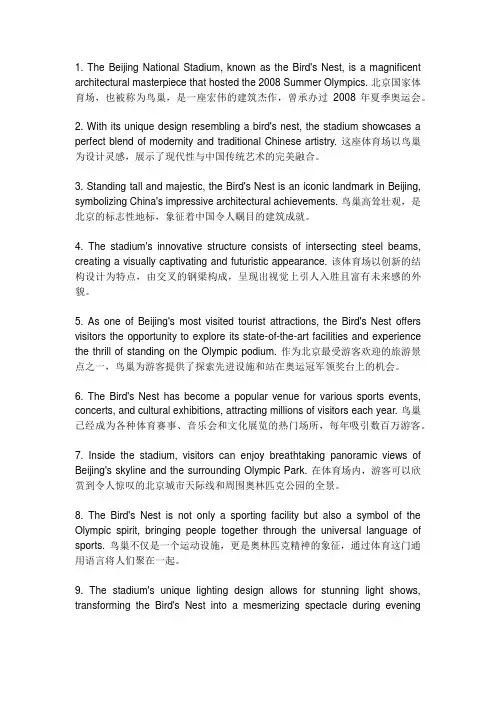
1. The Beijing National Stadium, known as the Bird's Nest, is a magnificent architectural masterpiece that hosted the 2008 Summer Olympics. 北京国家体育场,也被称为鸟巢,是一座宏伟的建筑杰作,曾承办过2008年夏季奥运会。
2. With its unique design resembling a bird's nest, the stadium showcases a perfect blend of modernity and traditional Chinese artistry. 这座体育场以鸟巢为设计灵感,展示了现代性与中国传统艺术的完美融合。
3. Standing tall and majestic, the Bird's Nest is an iconic landmark in Beijing, symbolizing China's impressive architectural achievements. 鸟巢高耸壮观,是北京的标志性地标,象征着中国令人瞩目的建筑成就。
4. The stadium's innovative structure consists of intersecting steel beams, creating a visually captivating and futuristic appearance. 该体育场以创新的结构设计为特点,由交叉的钢梁构成,呈现出视觉上引人入胜且富有未来感的外貌。
5. As one of Beijing's most visited tourist attractions, the Bird's Nest offers visitors the opportunity to explore its state-of-the-art facilities and experience the thrill of standing on the Olympic podium. 作为北京最受游客欢迎的旅游景点之一,鸟巢为游客提供了探索先进设施和站在奥运冠军领奖台上的机会。
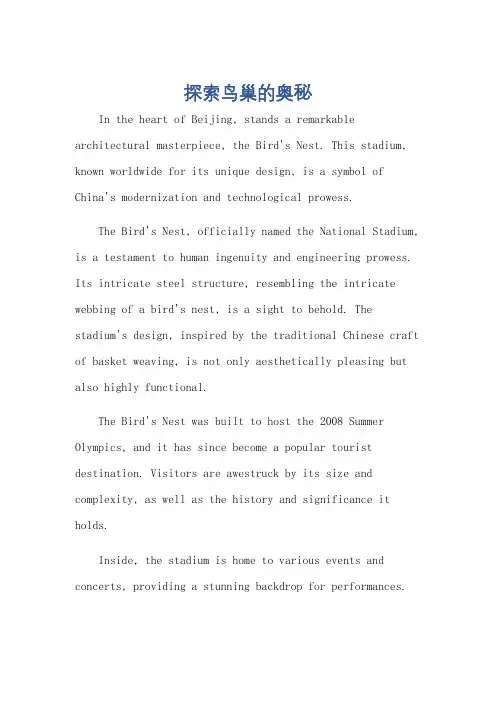
探索鸟巢的奥秘In the heart of Beijing, stands a remarkable architectural masterpiece, the Bird's Nest. This stadium, known worldwide for its unique design, is a symbol ofChina's modernization and technological prowess.The Bird's Nest, officially named the National Stadium, is a testament to human ingenuity and engineering prowess. Its intricate steel structure, resembling the intricate webbing of a bird's nest, is a sight to behold. Thestadium's design, inspired by the traditional Chinese craft of basket weaving, is not only aesthetically pleasing but also highly functional.The Bird's Nest was built to host the 2008 Summer Olympics, and it has since become a popular tourist destination. Visitors are awestruck by its size and complexity, as well as the history and significance it holds.Inside, the stadium is home to various events and concerts, providing a stunning backdrop for performances.The acoustics are impeccable, ensuring that every note and every word is heard clearly.The Bird's Nest is not just a stadium; it's a symbol of China's rise to global prominence. Its unique design and functionality have earned it worldwide recognition and admiration. Visiting the Bird's Nest is an experience that will leave you breathless and inspired.鸟巢探秘在北京的中心,屹立着一座非凡的建筑杰作——鸟巢。
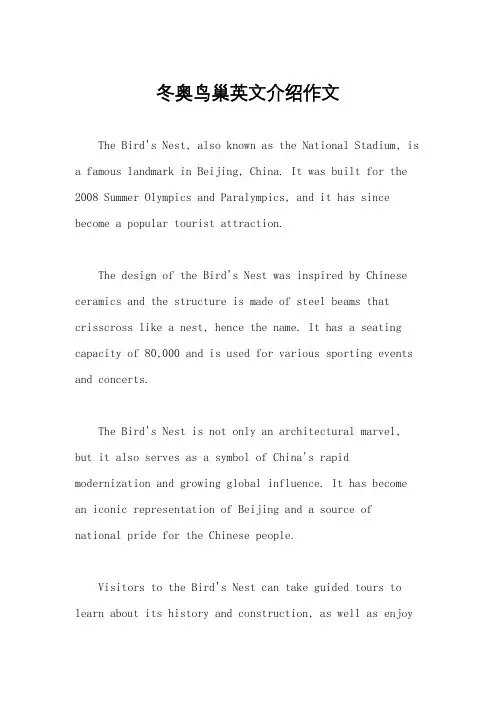
冬奥鸟巢英文介绍作文The Bird's Nest, also known as the National Stadium, is a famous landmark in Beijing, China. It was built for the 2008 Summer Olympics and Paralympics, and it has since become a popular tourist attraction.The design of the Bird's Nest was inspired by Chinese ceramics and the structure is made of steel beams that crisscross like a nest, hence the name. It has a seating capacity of 80,000 and is used for various sporting events and concerts.The Bird's Nest is not only an architectural marvel, but it also serves as a symbol of China's rapid modernization and growing global influence. It has become an iconic representation of Beijing and a source ofnational pride for the Chinese people.Visitors to the Bird's Nest can take guided tours to learn about its history and construction, as well as enjoypanoramic views of the stadium and the surrounding Olympic Park. It is also a popular spot for taking photos and soaking in the atmosphere of this world-renowned venue.In addition to its sporting and entertainment functions, the Bird's Nest has also been used for cultural and diplomatic events, further solidifying its status as a versatile and important landmark in Beijing. It continuesto attract visitors from around the world who are eager to experience its grandeur and significance.。
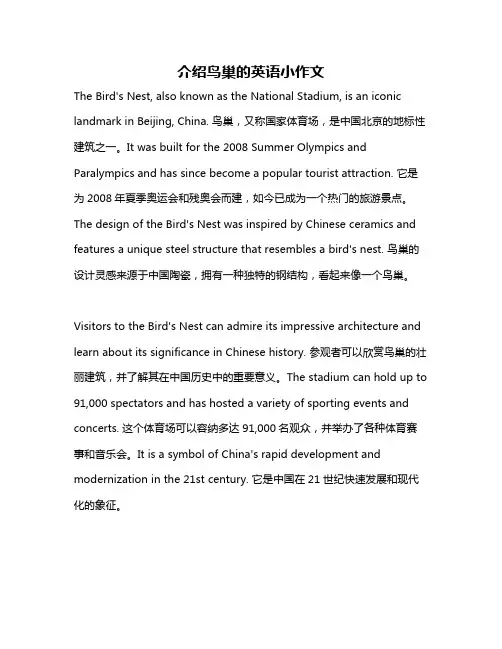
介绍鸟巢的英语小作文The Bird's Nest, also known as the National Stadium, is an iconic landmark in Beijing, China. 鸟巢,又称国家体育场,是中国北京的地标性建筑之一。
It was built for the 2008 Summer Olympics and Paralympics and has since become a popular tourist attraction. 它是为2008年夏季奥运会和残奥会而建,如今已成为一个热门的旅游景点。
The design of the Bird's Nest was inspired by Chinese ceramics and features a unique steel structure that resembles a bird's nest. 鸟巢的设计灵感来源于中国陶瓷,拥有一种独特的钢结构,看起来像一个鸟巢。
Visitors to the Bird's Nest can admire its impressive architecture and learn about its significance in Chinese history. 参观者可以欣赏鸟巢的壮丽建筑,并了解其在中国历史中的重要意义。
The stadium can hold up to 91,000 spectators and has hosted a variety of sporting events and concerts. 这个体育场可以容纳多达91,000名观众,并举办了各种体育赛事和音乐会。
It is a symbol of China's rapid development and modernization in the 21st century. 它是中国在21世纪快速发展和现代化的象征。
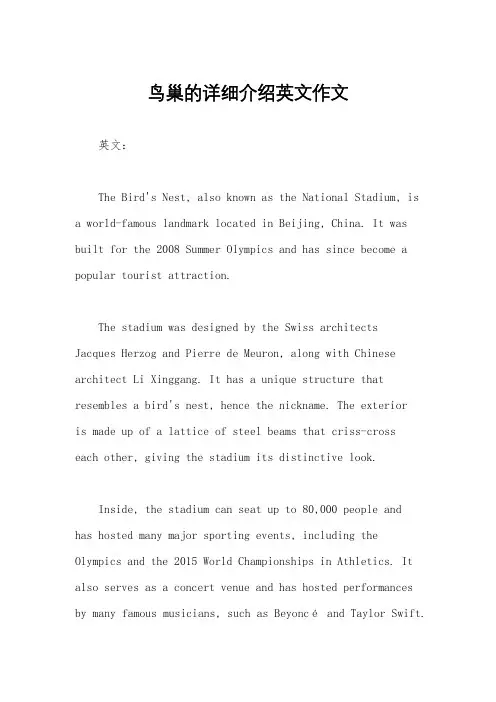
鸟巢的详细介绍英文作文英文:The Bird's Nest, also known as the National Stadium, is a world-famous landmark located in Beijing, China. It was built for the 2008 Summer Olympics and has since become a popular tourist attraction.The stadium was designed by the Swiss architects Jacques Herzog and Pierre de Meuron, along with Chinese architect Li Xinggang. It has a unique structure that resembles a bird's nest, hence the nickname. The exterioris made up of a lattice of steel beams that criss-cross each other, giving the stadium its distinctive look.Inside, the stadium can seat up to 80,000 people and has hosted many major sporting events, including the Olympics and the 2015 World Championships in Athletics. It also serves as a concert venue and has hosted performances by many famous musicians, such as Beyoncé and Taylor Swift.In addition to its impressive architecture and versatility, the Bird's Nest is also a symbol of China's rapid modernization and growing global influence. It has become a source of pride for the Chinese people and a representation of the country's ambition and innovation.中文:鸟巢,也称为国家体育场,是位于中国北京的世界著名地标。
鸟巢的简介资料英文作文英文:Nestled in the heart of Beijing, the Bird's Nest is an iconic stadium that was built for the 2008 Summer Olympics. Designed by Swiss architects Jacques Herzog and Pierre de Meuron, the stadium's unique structure resembles a bird's nest, hence its name.The Bird's Nest has a seating capacity of 91,000 and is the largest steel structure in the world. The stadium's construction took four years and cost approximately $423 million. The stadium is not only used for sporting events but also for concerts and other cultural events.One of the most memorable events held at the Bird's Nest was the opening ceremony of the 2008 Summer Olympics. The ceremony featured over 15,000 performers and showcased China's rich cultural heritage. The Bird's Nest has also hosted other major sporting events such as the 2015 WorldAthletics Championships and the 2022 Winter Olympics.The Bird's Nest is not only a symbol of China's architectural prowess but also its commitment to sports and culture. It has become a popular tourist attraction and a must-visit destination for anyone visiting Beijing.中文:鸟巢位于北京市中心,是为2008年夏季奥林匹克运动会而建的标志性体育场馆。
Bird’sNest的简介Bird’s Nest(鸟巢)是一座奥运主场馆,坐落于北京市奥林匹克公园内,建筑面积约26.6万平方米。
它是2008年北京奥运会和残奥会的开幕式和闭幕式的主场馆,是整个奥林匹克公园的核心建筑。
1.鸟巢的设计鸟巢的设计灵感源于中国古代的“魏、晋墓穴礼器——壺口”. 被誉为“中国屋脊”的鸟巢设计突出了中国传统文化中“天人合一”的思想,既与现代化建筑相得益彰,又具有浓郁的中国风。
建筑外形独特,像一只由钢铁和钢丝编织而成的国宝大鸟巢,树立了中国的标志性形象,成为了沉甸甸的国家象征。
2.鸟巢的结构鸟巢的主体结构是钢筋混凝土框架和结构吊杆。
为了增强结构的稳定性和承载力,鸟巢采用了世界上最先进的超越时代的技术,如弯曲钢材、空气加燃气喷吹焊接技术和多轴闭环轨道列车运输系统等。
结构上,鸟巢主要承受负重压力,而外表则是由钢材与筋混凝土所组成的圆形设计,看上去是一个大巨蛋,很美观,容量大,起伏连续,使其成为最具观赏性的建筑之一。
3.鸟巢的用途作为北京奥运会和残奥会的主场馆,鸟巢举办了多项比赛、开闭幕式和其他重大活动。
然而,奥运会结束后,鸟巢的用途一直是个问题。
鸟巢利用了现代化科技和多功能性,如在奥运会之后,鸟巢被改造成了世界最大的室内滑冰场,新设了非常独特的滑冰道,可以多人同时进行高速滑冰,达到滑行速度的540公里/小时. 鸟巢还设有本领域最先进的空气净化装置,如果你不是滑冰爱好者,可以到鸟巢里感受一下这些工程师们的智慧成果。
4.鸟巢的意义鸟巢不仅是奥林匹克公园的核心建筑,也是中国文化艺术领域的一大重要场所。
鸟巢的落成,不仅体现了中国在当代建筑领域的创新和进步,同时也是中国知识分子为其付出努力和智慧的结晶。
鸟巢的出现,将中国的文化和现代工程技术结合在一起,并发挥出了强大的经济和文化价值,成为全球知名的奥林匹克主场馆。
总之,“鸟巢”将是人们一直记得的地方,它代表了中国文明和奥林匹克精神,是现代化与传统文化完美结合的代表之一,每一个人都应该来这儿亲身感受一下鸟巢的独特魅力。
介绍鸟巢的英语作文60词The Bird's Nest is a famous landmark in Beijing, China. It was built for the 2008 Olympic Games and is now a popular tourist attraction. The Bird's Nest is a large stadium with a unique design that resembles a bird's nest. It is made of steel and has a capacity of 91,000 people.The Bird's Nest is not only a sports stadium but also a cultural icon. It has hosted many international events, including the opening and closing ceremonies of the 2008 Olympic Games. The stadium's design represents the harmony between humans and nature, and it has become a symbol of China's rapid development.Inside the Bird's Nest, there are many facilities for sports and entertainment. There is a track and field area for various sports events, as well as a swimming pool and a gymnasium. The stadium also has restaurants, shops, and exhibition halls, where visitors can learn more about the history and culture of the Olympic Games.Visiting the Bird's Nest is a unique experience. The stadium offers guided tours, where visitors can explore the different areas of the stadium and learn about its construction and design. There is also a skywalk that allows visitors to walk on the roof of the stadium and enjoy panoramic views of Beijing.The Bird's Nest is not only a popular touristattraction but also a symbol of China's ambition and innovation. Its unique design and impressive size make it a must-visit destination for anyone visiting Beijing. Whether you are a sports fan or not, the Bird's Nest is a placethat will leave you in awe of its beauty and significance.。
关于奥运会鸟巢的英语作文The Bird's Nest, also known as the National Stadium, is an iconic landmark in Beijing, China. It was the main venue for the 2008 Summer Olympics and Paralympics, and its unique design made it stand out among other sports stadiums around the world.The Bird's Nest is not only a sports stadium, but also a symbol of China's rapid development and modernization.Its intricate steel structure and innovative design have captivated people from all over the world, making it a must-see attraction for tourists visiting Beijing.The stadium's nickname, the Bird's Nest, comes from its resemblance to a giant nest made of steel beams. This nickname reflects the harmony between nature and modern architecture, blending traditional Chinese culture with contemporary design elements.Visitors to the Bird's Nest can not only admire itsimpressive exterior, but also explore its interior spaces, including the VIP rooms, athlete facilities, and even a museum dedicated to the 2008 Olympics. The stadium continues to host various sports events, concerts, and cultural activities, keeping its legacy alive.Overall, the Bird's Nest is more than just a sports venue – it is a symbol of China's ambition, creativity, and cultural heritage. Its impact goes beyond the world of sports, inspiring people to dream big and reach for the stars.。
鸟巢导游词英文范文用英语写关于鸟巢的导游词是不是让你很头疼。
那么下面,店铺为大家带来了鸟巢导游词英语范文,欢迎大家阅读。
鸟巢导游词英语范文The National Stadium Bird's Nest is the main stadium for the 2008 Beijing Olympic Games. The design of the giant stadium completed by Herzog, De Mellon and Chinese architect Li Xinggang, who won the Plic Prize in 2001, was designed by Ai Weiwei as a design consultant. Form is like a " nest" that breeds life. It is more like a cradle that holds human hopes for the future. Designers didn't do any extra work on the national stadium, but frankly exposed the structure, thus naturally forming the appearance of the building." Bird's Nest" is mainly composed of huge portal steel frames with 24 truss columns. The top surface of the National Stadium is saddle - shaped, with a major axis of 332.3 meters, a minor axis of 296.4 meters, a highest point of 68.5 meters and a lowest point of 42.8 meters.The design of the Bird's Nest fully embodies the humanistic care. The bowl-shaped seats encircle the folding structure of the stadium, and the upper and lower floors are strewn at random. No matter where the audience sits, the distance of sight from the center of the stadium is about 140 meters. The sound-absorbing film material used in the lower layer of the " Bird's Nest", the sound-absorbing material arranged on the steel structure member, and the electroacoustic sound amplification system used in the stadium, these three layers of " special devices" make the index of speech intelligibility in the " Bird's Nest" reach 0.6 - this number ensures that the audience sitting in any position canhear the broadcast clearly. The designers of the Bird's Nest also used fluid mechanics to simulate the natural ventilation of 91,000 people watching the competition at the same time, so that all spectators can enjoy the same natural light and natural ventilation. More than 200 wheelchair seats have also been set up for the disabled in the auditorium of the Bird's Nest. These wheelchair seats are slightly higher than ordinary seats, ensuring that disabled people have the same vision as ordinary spectators. During the Games - time, hearing AIDS and a wireless broadcasting system will be provided to provide personalized services for people with hearing and vision impairments.Many architectural experts believe that the " Bird's Nest" will not only set up a unique and historic landmark for the 2008 Olympic Games, but will also have pioneering significance in the development of world architecture and will provide historical witness for the development of Chinese and world architecture in the 21st century.鸟巢导游词用英文怎么写Hello everyone, let me tell you about the basic situation of " Bird's Nest". . " Bird's Nest" is the main stadium of the 29th Olympic Games in 2008. The project covers a total area of 21 hectares and a construction area of 258,000 000m2. There are about 91,000 seats for spectators in the venue, of which about 11,000 are temporary seats. The Olympics, Paralympics Opening and Closing Ceremonies, Track and Field Events and Football Finals were held. After the Olympics, it became a large-scale professional place for Beijing citizens to participate in sports activities and enjoy sports entertainment, and became a landmark sports building and Olympic heritage. Look at the steel net above, the total weight of the " Bird's Nest" steel structure is4. 20,000 tons, with a maximum span of 343 meters, and a stadium surrounded by a huge steel net and covering 90,000 people; The sightseeing staircase naturally becomes an extension of the structure. The pillar disappears, the evenly stressed net has no clear direction like a branch, making people feel that every seat is equal, and staying in it is like returning to the forest. Filter the sunlight into a diffuse inflatable membrane, leaving the stadium free from the shadow of sunlight. The whole terrain is 4 meters high and the interior is used as an auxiliary facility, thus avoiding the huge investment spent by the lower earth digger. " Bird's Nest" adopts the advanced construction technology today, and all the projects have 20 or 30 technical problems, among which the steel structure is unique in the world. All right, I've finished my introduction to the " Bird's Nest". Next, let's go and visit the " Bird's Nest".鸟巢导游词英语作文怎么写Hello everyone, welcome to the National Stadium " Bird's Nest". We are going to enter the " Bird's Nest" here today as the main stadium for the 29th Olympic Games in 2008. The project covers a total area of 21 hectares and a construction area of 258,000m2. There are about 91,000 seats for spectators in the venue, of which about 11,000 are temporary seats. The Olympics, Paralympics Opening and Closing Ceremonies, Track and Field Events and Football Finals were held. After the Olympics, it became a large-scale professional place for Beijing citizens to participate in sports activities and enjoy sports entertainment, and became a landmark sports building and Olympic heritage.Look at the steel net above, the steel structure of the " Bird's Nest" is 42000 tons in total weight, with a maximum span of 343 meters, and is enclosed with a huge steel net covering thestadium of 90000 people. The sightseeing staircase naturally becomes an extension of the structure. The pillar disappears, the evenly stressed net has no clear direction like a branch, making people feel that every seat is equal, and staying in it is like returning to the forest. Filter the sunlight into a diffuse inflatable membrane, thus leaving the stadium free from the shadow of sunlight. The whole terrain is 4 meters high and the interior is used as an auxiliary facility, thus avoiding the huge investment spent by the lower earth digger. The " Bird's Nest" adopts today's advanced construction technology. All the projects have 20 or 30 technical problems, among which the steel structure is unique in the world.All right, now let's have a free tour.。
鸟巢景点英文介绍作文英文:The Bird's Nest is a famous tourist attraction in Beijing, China. It is a large stadium that was built forthe 2008 Summer Olympics. The stadium has a unique design that resembles a bird's nest, hence the name. It is made of steel and has a seating capacity of 80,000 people.I have been to the Bird's Nest twice and both timeswere amazing experiences. The first time I went was during the day and I was able to see the intricate details of the stadium's design. The second time I went was at night and the stadium was lit up with colorful lights, which was a breathtaking sight.There are also many activities to do at the Bird's Nest. One of my favorite activities was the zipline that goesfrom one end of the stadium to the other. It was athrilling experience and I felt like I was flying over thestadium. There is also a museum inside the stadium that showcases the history of the Olympics and the construction of the Bird's Nest.Overall, the Bird's Nest is a must-see attraction in Beijing. It is not only a beautiful stadium, but it also has a rich history and offers many fun activities for visitors to enjoy.中文:鸟巢是中国北京著名的旅游景点。
2008奥运会鸟巢的英文介绍篇一:奥运:鸟巢简介鸟巢简介国家体育场(鸟巢)位于北京奥林匹克公园中心区南部,国家体育场(鸟巢)为2008年第29届奥林匹克运动会的主体育场。
国家体育场(鸟巢)工程总占地面积21公顷,国家体育场(鸟巢) 建筑面积为25.80万平方米。
南北长有330米,东西宽近294米,高69米。
钢结构总用钢量为万吨。
可以容纳万人。
国家体育场(鸟巢)内观众坐席约为91000个,其中固定座席80000个,临时坐席约11000个。
国家体育场(鸟巢)将举行奥运会、残奥会开闭幕式、田径比赛及足球比赛决赛。
篇二:奥运会开幕式中英文稿北京奥运会开幕式中英文演讲稿 (2008-09-13 20:22:39)转载标签:身边的奥运奥运杂谈8月8日20时,第29届奥林匹克运动会开幕式正式在国家体育场拉开帷幕。
中国国家主席、国际奥委会主席入场中国国家主席胡锦涛、国际奥委会主席雅克-罗格进入VIP贵宾席。
主持人:美丽的欢迎焰火绕场一周,在鸟巢上空花朵般绽放,激活了古老的日晷。
在鸟巢上方显得格外漂亮,富有太阳投射的影子来测定时间计时日期的日晷,由日晷发出的时间之光点亮了鸟巢,点亮了2008面缶组成的矩形缶阵。
倒计时主持人:一道耀眼的光环,激活了古老的日晷。
独特的多媒体手段,拉开了开幕式的帷幕。
日晷将光反射到场地的缶上。
缶是中国古老的打击乐器,由陶土或青铜制成。
早在夏、商时代,就有了“击缶而歌”的演奏。
此刻它们正以光的律动向我们传递光阴的概念。
和着击打声,出现巨大的数字,每次光影数字的交锋,都预示着北京奥运的每秒临近,就让我们穿越时空,一同倒数,用震撼的节奏,激荡千年祖国的万里疆土,激荡中华民族的奔腾血脉,共同迎接奥运之光的莅临。
欢迎焰火今夜星光灿烂,8月的中国以如火的热情诚邀八方来客,广纳四海宾朋,今夜礼花满天,仲夏的北京见证天国奇迹,铸造荣耀巅峰。
(现场主持人)欢迎中华人民共和国主席胡锦涛先生,国际奥林匹克委员会主席雅克-罗格先生。
欢迎仪式夜空璀璨,缶声震天,情谊无边,接下来我们将会看到一场独具中国古典艺术魅力的欢迎仪式,欢迎所有远道而来的朋友。
中国素以文明古国,礼仪之邦著称于世,几千年来不仅创造了灿烂悠久的历史文化,更形成了高尚道德准则和完整的礼仪规范。
此刻,2008名乐手,一边击缶,一边高声吟诵着数千年前孔子写在论语中的名句,我们用独特的方式,表达北京最真挚的欢迎之情。
欢迎所有热爱友谊与和平的朋友们来到北京,来到中国,欢迎所有热爱奥林匹克运动的朋友们来到奥林匹克大家庭。
历史足迹在震撼的声响中,我们惊喜地看到,由焰火组成的巨大脚印正沿着北京的中轴路穿过天安门广场直奔国家体育场而来。
29个焰火脚印象征着29届奥运会的历史足迹,也意味着中国追寻奥运之梦的百年跋涉正在一步步走近,梦想成真的时刻。
7年前当中国人把申办报告交给国际奥委会的时候,就把绿色奥运、科技奥运和人文奥运的承诺交给了世界。
7年后,中轴路上新生的鸟巢和孕育出生的奥林匹克森林公园成为了庄严的天安门广场最欢乐的伙伴。
中轴路上这三个特色鲜明的北京地标,不仅体现了北京奥运的三大理念,更连接起了北京城市的昨天和今天。
梦想五环此刻的鸟巢繁星点点,尤如浩瀚的星河落入人间。
美丽的飞天在繁星中歌舞,唯美浪漫,如梦如幻,为奥运五环增添一抹中国色彩,为奥运五环烙印一段中国的记忆,也像美丽的梦幻在中国人心中憧憬百年。
一个由星光组成的奥运五环散发着璀璨的光芒,美丽的飞天把闪光的五环托起在北京的夜空,点亮了北京的夜色,点亮了每个热爱和平、热爱友谊、热爱奥林匹克运动的人心中跃动的激情。
这个璀璨的五环会让我们记住北京的星空里终于有了奥运五环的印迹,更会让全世界都记住,奥运会的记忆中从此有了中国的传奇。
国旗入场(演唱)一曲旋律优美的响彻鸟巢的上空,56名各民族儿童簇拥在五星红旗的周围进入会场。
升中华人民共和国国旗,唱中华人民共和国国歌现场主持人:女士们,先生们请起立,升中华人民共和国国旗,奏中华人民共和国国歌。
(奏)当鲜艳的五星红旗迎风飘扬,绚丽的焰火绽放出古老的中国最灿烂的表情,这个夜晚属于腾飞的中国,这份喜悦属于奥运的北京。
1. Pre-ceremony PerformanceThe pre-show is performed both south and north of the National Stadium and on the tracks.Several national celebrities demonstrate and train the audience in an energetic and lively manner on the interactive elements in the ceremony.Animation video assists the training2008-member Fou Band enters from four gates, standing in a rectangular formation on the east and west sides of the field with a 22-meter wide passageway in the middle. The Fou is an ancient Chinese percussion instrument either made of bronze or ceramic.The 224-member Chorus dressed in 56 traditional Chinese ethnic costumes start to enter on both sides of the Chinese national flagpole.A child enters and stands in front ofthe flagpole.The 201-member Military Band enters and stands at the north of the Stadium.2. The Arrival of the Chinese President and the President of the IOC The President of the People’s Republic of China and the IOC President enter the Presidential Box.At the north of the Stadium, the Military Band plays welcome music.3. CountdownIn the last 10 seconds, the percussion rhythm of the “Fou Formation” is as intense as the roar of thunder. Chinese and Arabic numerals flash on the surfaces of the Fou successively, in tune with the rhythm ... 9, 8, 7, 6, 5,4, 3, 2, 1.A dazzling light activates an ancient sundial.The sundial reflects light onto the “Fou.”Fou are ancient Chinese percussion instruments made of clay or bronze. In as early as the Xia and Shang dynasties, Fou were used in song and dance performances.The rhythmic beating of the instruments coincides with the lights to convey the concept of “time.”4. Welcome fireworksSplendid fireworks burst from the Stadium’s exterior trusses, making the entire Stadium like a blossoming flower.5. WelcomeThe sound of the Fou is thunderous and the chant is roaring.Two-thousand-and-eight performers beat the Fou and sing to welcome friends from all over the world. The exciting percussion performance starts to create a rolling, thunderous welcome.The 2,008 Fou and their 2,008 musicians symbolize the 2008 Beijing Olympic Games.”Friends have come from afar, how happy we are.” This is a well-known saying of Confucius. Two-thousand-and-eight performers beat the Fou and sing to welcome friends fromall over the world.Confucius (551 BC-479 BC) was a famous educator and philosopher in ancient China. His thoughts deeply influenced later generations.6. Footprints of HistoryTwenty-nine colossal burning footprints symbolize 29 Olympiads.Twenty-nine colossal footprints rise to the sky in a series of fireworks. At a rate of one “footprint”per second, 29 of them march along Beijing’s central axis fromTian’anmen Square all the way to the Olympic Green and the National Stadium, symbolizing the path of the Games of the XXIX Olympiad and their arrival.The footprints consist of fireworks, representing the invention of gunpowder, one of the four great inventions in ancient China.7. Olympic RingsThe footprints change into clusters of falling stars, which gather to form the Olympic rings.The “footprints” pass through Tian’anmen Square and head north, with the last “footprint” exploding over the National Stadium, showering the Olympic venue with clusters offalling stars, which gather to form the five Olympic rings.Twenty graceful fairies float towards the ground and cluster around the Olympic rings, manifesting beauty and romance. Their costumes glow with light.8. Entry of the Chinese National FlagEight flag bearers carry the flag into the Stadium horizontally and solemnly display the Chinese national flag.A child sings A Hymn to My Country.篇三:2008年北京奥运会主体场—“鸟巢”“鸟巢”外形结构主要由巨大的门式钢架组成,共有24根桁架柱。